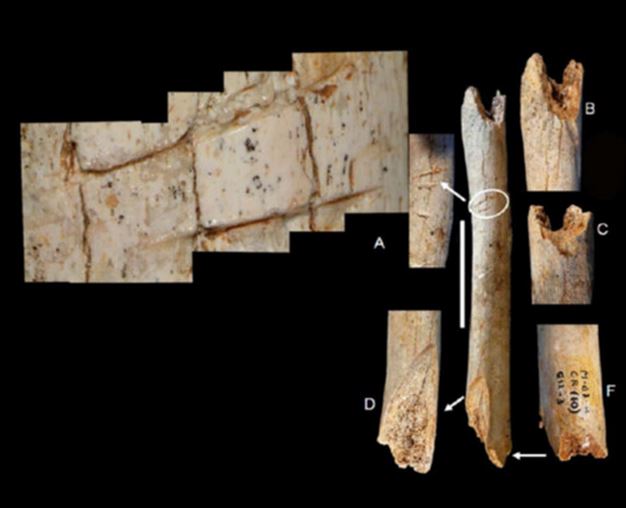Bone fossils of two adults and a child suggest Neanderthals may have eaten their dead children, as well as adult carcasses, say researchers from the University of Bordeaux in France. Evidence points to them cutting, beating and fracturing the bones of their recently deceased companions.
The Neanderthals are the extinct species of human in the genus Homo. They were closely related to modern humans, differing in DNA by just 0.12%.
Analysis of the specimens discovered in the Poitou-Charentes region of France in 1967 and 1980, show evidence of cuts made soon after death to sever limbs from the body.

Cut marks observed on the thigh bone of the Neanderthal child. (Credit: M.D. Garralda et al)
In this latest study, the authors explain in the American Journal of Physical Anthropology (citation below) that they revisited the 57,600 year-old fragments of the three specimens.
In an interview with Spain’s Information and Scientific News Service (SINC – Servicio de Información y Noticias Científicas), Professor María Dolores Garralda, who works at the Complutense University of Madrid, Spain, and is also a researcher at the University of Bordeaux, France, said:
“Some Neanderthal groups cut and tore apart child or adult corpses shortly after death (perimortem) using lytic instruments.”
There is no evidence of cuts or traces of carnivores’ teeth on the separated bones, which points to them being removed deliberately either to be eaten or used in some type of funeral ceremony.
A femur (thigh bone) fragment, which the scientists believe came from a child who died at the age of 9 or 10, has two large cut marks half-a-centimetre apart. Evidence suggests the bone was fractured while still fresh, with the cutters trying to separate the upper and lower extreme of the femur, where the joints are located.

Neanderthals were closely related to modern humans. (Image: Natural History Museum)
Prof. Garralda noted:
“The upper edge exhibits marks of a “post-mortem” impact with conchoidal markings (those that does not follow natural separation positions).”
“Given the morphology of the fractures, it may be that the body of this child was manipulated shortly after death. The right leg received a series of blows that fractured the femur, and the cut marks identified are anthropic in nature; in other words, there is no visible evidence of animal bites.”
Prof. Garralda believes they could have been done as part of a ritual. Similar procedures still exist today in certain parts of the world. She also suggests the limbs were separated “for food – gastronomic cannibalism, or due to need.”
Citation: “Neanderthal infant and adult infracranial remains from Marillac (Charente, France),” María Dolores Garralda, Bruno Meureille and Bernard Vandermeersch. American Journal of Physical Anthropology. DOI: 10.1002/ajpa.22557.
